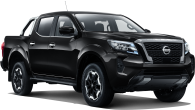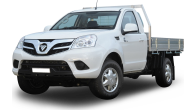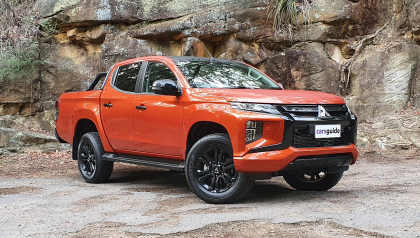The Great Wall brand in Australia has a mixed reputation. But one thing has always stayed the same - it plays on value and affordability above all else.
This new 2021 GWM Ute - which may also be known as the 2021 Great Wall Cannon - might change that. Because not only is the new dual-cab 4x4 pick-up a value-focused offering, it’s also really quite good.
It takes the brand to a new level. In fact, it takes it to another world compared to the old models; the world of the big-name players.
That’s because you could easily consider this as a closely priced competitor to an LDV T60 and SsangYong Musso - but likewise you might see it as a real budget alternative to the Toyota HiLux, Ford Ranger, Nissan Navara, Isuzu D-Max and Mazda BT-50. It even has some attributes that are more likeable than most of those utes, too.
Read on, we’ll give you the lowdown on the new 2021 GWM Ute.
GWM UTE 2021: Cannon-L (4X4)
| Engine Type | Diesel Turbo 4, 2.0L |
|---|---|
| Fuel Type | Diesel |
| Fuel Efficiency | 9.4L/100km (combined) |
| Seating | 5 |
| Price From | $22,330 - $27,610 |
Does it represent good value for the price? What features does it come with?
9 / 10
You used to be able to get a Great Wall ute for as little as twenty grand - drive-away! That’s not the case anymore, though… well, not with the GWM Ute, which has taken a big step up in price, but still remains one of the most affordable dual-cab 4WD utes on the market.
The three-tier GWM Ute range kicks off with the entry-level Cannon variant, which lists at $33,990 drive-away.
That price scores you 18-inch alloy wheels, body-coloured bumpers, LED headlights with LED DRLs and active fog lamps, side steps, powered mirrors, keyless entry, push-button start, and a shark-fin antenna.
.jpg)
Inside it comes with fake ‘Eco Leather' seats, manual air-conditioning, carpet flooring, and a polyurethane steering wheel with paddle shifters for the automatic gearbox. Even at this grade you get a 9.0-inch touchscreen media system with Apple CarPlay and Android Auto, and the stereo has four speakers as well as AM/FM radio. A second 3.5-inch screen lives in the driver's binnacle, and it includes a digital speedometer and trip computer.
.jpg)
The base model Cannon also has a USB power outlet for a dash camera, three USB ports and a 12-volt power outlet in the rear, and rear-seat directional air vents as well.
Step up to the Cannon L, which costs $37,990 drive-away, and you net a few desirable extras for your additional dough. The Cannon L is the vehicle you see in the video review.
The Cannon L can be picked from the outside thanks to its "premium" 18-inch alloy wheels (which it shares with the model above it), while at the back you get a spray-in tub liner, a sports bar, and easy-down-up tailgate, a deployable cargo ladder and roof rails.
.jpg)
Inside, the front seats are heated, the driver's seat has power adjustment, there's a leather steering wheel, as well as climate control air conditioning (single zone), an auto-dimming rearview mirror, tinted rear glass, and the sound system jumps to a six-speaker unit.
The top-of-the-range GWM Ute Cannon X model overshoots the psychological barrier of forty grand, with a drive-away price of $40,990.
The top-spec model gets a pretty upmarket treatment, though, with quilted real leather seat trim, quilted leather door trims, power adjustment for both front seats, a wireless phone charger, voice recognition, and a 7.0-inch digital driver screen. The front also sees a redesigned centre console layout, which is cleverer than the lower grades.
.jpg)
Plus the back seat adds a 60:40 split fold setup, as well as a fold-down armrest. The cabin further gains reach adjustment for the steering (which really should be standard on all grades - instead, the lower specs had tilt adjust only), and the driver has selectable steering modes, too.
.jpg)
So, what about standard safety technology? It used to be that Great Wall models largely went without the sort of safety gear you found in mainstream utes. That’s no longer the case - see the safety section for the breakdown.
Colours available for the GWM Ute range include Pure White at no cost, while the Crystal Black (as seen in our video), Blue Saphire, Scarlet Red and Pittsburgh Silver add $595 to the price.
Is there anything interesting about its design?
8 / 10
The all-new GWM Ute is a big unit. It has that truck-like stance thanks in part to its huge, high grille, and you have to love that all GWM Ute models come with LED headlights, LED daytime running lights and LED tail-lights, and the front lighting is automatic, too.
To my eye, it appears to have drawn some inspiration from the likes of the Toyota Tacoma and Tundra models and it’s even reminiscent of the current-look HiLux, with that front-end design offering a bold appeal. And if you are wondering what that big symbol on the grill stands for, it’s the Chinese model branding for this vehicle - in its home market the Ute goes by the model name “Poer”, while other markets name it “P Series”.
.jpg)
The profile view is dominated by the eye-catching 18-inch alloy wheels, which are clad in Cooper tyres - nice. And it’s a pretty attractive side-on view - not too curvy, not too busy, just a conventional pick-up truck look.
The rear has a neat and tidy look, though some might not be fans of the clear-look tail-light treatment.
.jpg)
My favourite features are at the back end, including the spray-in tub liner / tray lining, which is so much better than a rubber or plastic-shell lining - it offers better durability, protects the paint, and never looks shonkily fitted as some plastic liners do.
Plus the Cannon L and Cannon X models also get the excellent tailgate step, which pops out of the top of the strut-equipped tailgate and means you don’t have to do your yoga stretches before trying to get up in the tray.
.jpg)
Now, it is large, this new ute. It measures 5410mm long on a 3230mm wheelbase, and also spans 1934mm tall and 1886mm wide, meaning it’s about the same size as a Ford Ranger, if you’re wondering.
There is no off-road review as part of this early launch-loan test, but if you want to know the important angles, here they are: approach angle - 27 degrees; departure angle - 25 degrees; ramp / breakover angle - 21.1 degrees (unladen); ground clearance mm - 194mm (laden). Want to know how it goes off-road? Stay tuned, we’ll do an Adventure review soon.
The interior design has come leaps and bounds beyond what we’ve seen from the Great Wall models of the past. This is a contemporary cabin design, with a big 9.0-inch media screen dominating the design, and much better quality materials than before. The finishes aren’t as fetching in the low- and mid-grade models, but the top-spec Cannon X’s leather trim with quilting hits the nail on the head for those who want a bit of luxury for little money.
.jpg)
Read the next section to see how the interior stacks up from a practical standpoint, and check out our interior images below.
How practical is the space inside?
7 / 10
Big outside, spacious inside. That’s a good way to describe the GWM Ute.
In fact, if we start from the back seat, it’s fair to say the new Cannon range is among the roomiest in the class, with plenty of space for someone my size - 182cm or 6’0” - to have ample space. With the driver’s seat set for me, I had good toe, knee and head room in the back row, and there’s good width to the cabin as well - plus there’s no huge transmission tunnel intrusion, so three adults won’t be an issue.
.jpg)
If you’re going to use the ute for child transport, there are dual ISOFIX child seat anchors and two top-tether points as well. They’re not the fabric loop type, either - they’re a fixed steel anchor in the rear wall of the cabin. The Cannon X’s smart 60:40 rear-seat layout is something that could win some buyers over, especially those with kids.
.jpg)
Nice touches for rear-seaters include directional air vents, a USB charge port and 220-volt powerpoint to keep devices charged up, while there are map pockets and bottle holders in the doors, but no fold-down armrest in the lower two grades, and no rear cup holders in any grade.
.jpg)
Up front there is okay adjustment for the driver’s seat but, again, the lack of reach adjustment for the steering wheel on the Cannon and Cannon L models seems like crude cost-cutting, as it should be standard if you can get it.
I found myself not being able to get my ideal driving position because of the lack of reach adjust on the Cannon L, and there are a few other ergonomic quirks, too. Things like the buttons for the driver info display - the OK button on the wheel requires a three-second-press to show the menus - and the actual usability of it is a bit hit and miss, with it seemingly impossible to get the digital speed readout to stay on screen when you have lane keeping active.
.jpg)
You also have to go through the screen to adjust those settings, and the lane keep system will be on as default every time you start the car. Plus a digital display for the set air-con temperature - rather than through the screen - would be nice, and the seat heating is activated by a button on the console but you have to adjust the level through the screen. Not excellent.
That said, the screen is mostly excellent - quick to react, clear in its display, and pretty easy to get to grips with, but it is especially good if you plan to use it primarily as a mirror for your smartphone. I had no issues with the Apple CarPlay connectivity across multiple drives, and that’s more than I can say for some rival utes. The sound system is only okay, too.
There is reasonable storage, with a pair of cupholders between the seats, bottle holders and trenches in the doors, and a small storage section in front of the gear shifter and a covered centre console with an armrest cover. That armrest is annoying in the Cannon and Cannon L models, as it moves forward too easily, meaning the lightest lean can jolt it forward. In the Cannon X, there’s a better, more sturdy console design.
.jpg)
The glovebox is reasonable, there’s a sunglass holder for the driver, and overall it is fine for interior practicality but doesn’t set any new benchmarks.
The materials are where things feel a bit cut-price, especially in the Cannon and Cannon L. The fake leather seat trim isn’t very convincing, while the leather trim on the steering wheel (Cannon L up) isn’t terrific either. I do like the design of the wheel, though - it looks kind of like an old Jeep or even the PT Cruiser. Not sure if that was intentional or not.
What are the key stats for the engine and transmission?
7 / 10
Under the bonnet of the GWM Ute is a 2.0-litre four-cylinder turbo-diesel engine. We know, that sounds small, and the power outputs aren’t enormous either.
GWM says the diesel mill pumps out 120kW of power (at 3600rpm) and 400Nm of torque (from 1500-2500rpm). Those figures are below most rivals in the mainstream ute scene, but in practice the ute offers pretty strong response.
.jpg)
The GWM Ute is fitted only with an eight-speed automatic transmission, and all grades have paddle shifters. It has an on-demand four-wheel drive system (4WD or 4x4), with the drive mode selector essentially dictating proceedings. In Eco mode the ute will essentially run in 4x2 / RWD, while in Std/Normal mode and Sport mode it powers all four wheels. There is a low-range transfer case and a rear differential lock in all grades, too.
.jpg)
The GWM Ute has a kerb weight of 2100kg, which is heavy. But it has a towing capacity of 750kg for unbraked loads and 3000kg for braked trailers, which is below the standard in the segment of 3500kg.
The gross vehicle mass (GVM) for the ute is 3150kg, and the gross combination mass (GCM) is 5555kg, according to the brand.
How much fuel does it consume?
7 / 10
The official combined cycle fuel consumption figure for the Great Wall Cannon model range is 9.4 litres per 100 kilometres, which is decent considering this is a two-tonne-plus truck.
In our testing, which comprised urban, highway, back road and country driving, we saw an at-the-pump real-world fuel economy figure of 9.9L/100km.
.jpg)
The GWM Ute has a 78-litre fuel tank capacity. There is no long-range fuel tank option and the engine doesn’t have fuel-saving start-stop technology as some of its rivals do.
The GWM Ute runs at Euro 5 emissions standards, with a diesel particulate filter (DPF) fitted. Its emissions are stated at 246g/km CO2.
What's it like to drive?
7 / 10
The engine is a huge highlight here. In the old Great Wall Steed, the engine and transmission were its biggest negative. Now, though, the GWM Ute’s powertrain is a really strong offering.
It isn’t the most refined engine in the world, but it is punchier than its outputs suggest it probably should be. There’s strong pulling power across a broad spectrum of the rev-range, and in rolling acceleration it has enough torque to push you back in your seat.
It’s just that when you take off from a standing start, there’s plenty of turbo lag to contend with. It’s hard to get away from a traffic light or stop sign without having to think ahead about the lag you’re going to encounter, so that’s something that could be better - most of the mainstream utes have less turbo lag from a standing start.
The engine teams well with the eight-speed automatic transmission, which is pretty smart in the way it behaves, and mostly does what you’d expect of it. There is some tendency to rely on the engine torque and labour gears, to the point that there’s excessive vibration noticeable (you can even see the rearview mirror shaking), but I’d prefer that than an overactive transmission that didn’t rely on the grunt available to keep things moving.
.jpg)
There are paddleshifters if you want to take matters into your own hands, though I wish the actual gear selector had a manual mode, which would make it easier to manipulate the ratios when cornering, as the turning action is pretty laborious and you can get caught mid-bend wanting to change up or down a gear.
Note - our drive loop for this launch test was primarily on paved roads, and we didn’t do a load test as part of this early preview drive. Stay tuned to see how the GWM Ute copes with a Tradie test where we push it to its GVM limits, and how it handles itself in the rough stuff when we do an Adventure review.
I did, however, drive on some unsealed gravel roads, and was largely impressed by the handling, control and comfort on offer, aside from an overactive stability and traction control system that tends to chew away at your power when you’re accelerating out of a slippery corner, causing it to feel a tad bogged down at times.
But in other ways, the GWM Ute was great to drive on-road, with a comfortable and mostly composed ride, especially at higher speeds. It can still feel like a ladder-frame chassis ute with leaf-spring suspension and oversized wheels when you’re encountering lumps and bumps at low speeds, but it certainly felt better to drive and more comfy in that situation than a HiLux without weight on board.
.jpg)
The steering is hefty and fine to operate, with nice light weighting at lower speeds and, when the lane keeping assist system is disabled, there’s decent feel and heft at higher speeds. But that lane-keep system can otherwise be overly assertive, and I found myself wanting to disable the system every time I drove the vehicle (which you have to do by pressing a button, then finding the correct section on the menu on the media screen, then toggling the ‘switch’). I hope GWM can find a way to make this simpler and smarter.
Indeed, that was another criticism - the lane assist system seemingly overrules the ability to have a digital speed readout on the 3.5-inch cluster. I know I prefer to watch my speed as a matter of priority.
All in all the drive experience is a good one, considering the price of the ute. Sure, a five-year old Ranger or Amarok is still going to feel more refined, but you won’t be getting that ‘new car’ feeling, and you might be buying someone else’s problems… for almost the same money as you can buy a brand-new Great Wall Cannon model.
Warranty & Safety Rating
What safety equipment is fitted? What safety rating?
9 / 10
Safety has long been a key consideration for those in the market for budget-focused utes. It used to be that if you bought a cheap ute, you were deciding to forego advanced safety technology.
That’s not the case nowadays, though, with the new GWM Ute offering an extensive range of safety tech that is at the benchmark level for established ute brands.
The range comes as standard with autonomous emergency braking (AEB) that works between 10km/h and 130km/h for vehicle detection, while it can also detect and brake for pedestrians and cyclists from 5km/h to 80km/h.
The ute also features Lane Departure Warning and Lane Keep Assist, the latter of which operates between 60km/h and 140 km/h, and can help keep you in your lane by actively steering.
There’s also blind-spot monitoring and rear cross-traffic alert, as well as speed sign recognition, and the usual array of braking and stability assistance systems. Also of note is the standard-fit four-wheel disc brakes (as opposed to rear drums, like most utes still have) and an electronic park braking with auto-hold system. There is also hill descent control and hill-hold assist.
The GWM Ute Cannon model has a reversing camera and rear parking sensors, as well as front kerbside cameras to help you see ahead. The Cannon L and Cannon X models have a surround view camera system - which is one of the best this tester has used - plus those grades add front parking sensors as well.
.jpg)
The GWM Ute range has seven airbags, with dual front, front side, full-length curtain and front centre airbag protection, the latter of which is designed to prevent head clashes in side-impact crashes.
That said, it hasn’t yet been awarded an ANCAP crash test rating. We’ll have to see if it can max out like the D-Max and BT-50, which this ute almost mirrors for safety tech.
What does it cost to own? What warranty is offered?
8 / 10
The Great Wall brand - now GWM - has pumped up its warranty cover to be seven years/unlimited kilometres, which makes it one of the best in the ute class for warranty. Better than a Ford, Nissan, Mazda or Isuzu, equal to the SsangYong, but not quite as good as the Triton (10 years).
The brand also offers five years of roadside assistance for free, which should put some potential customers’ minds at ease over potential reliability concerns.
There is, however, no capped price servicing plan. The first service visit is due at six months, before a regular maintenance schedule with intervals set every 12 months/10,000km, which could be a tad annoying for those who do a lot of mileage.
Got questions about Great Wall reliability, quality, issues, problems, faults or recalls? Head to your Great Wall problems page.
Verdict
The all-new GWM Ute, or Great Wall Cannon, is a very big improvement over any Great Wall ute that has come before it.
It’s good enough to worry the LDV T60 and SsangYong Musso, and with a long warranty backing it up, could also cause some customers considering mainstream, big-name utes to take a look at the reborn and renamed Great Wall Cannon. Talk about bang for your buck! Geddit? Cannon? Bang?
Anyway. Depending on your intended use, you probably don’t ‘need’ anything more than the entry-level Cannon model, though if I was after that more loveable ute experience - not just a work truck - I’d be tempted by the Cannon X, the interior of which is a marked step up in terms of desirability.





.jpg)

.jpg)
.jpg)
.jpg)








.jpg)




.jpg)